light Peugeot 508 RXH 2014 Owner's Manual
[x] Cancel search | Manufacturer: PEUGEOT, Model Year: 2014, Model line: 508 RXH, Model: Peugeot 508 RXH 2014Pages: 338, PDF Size: 10.81 MB
Page 4 of 338
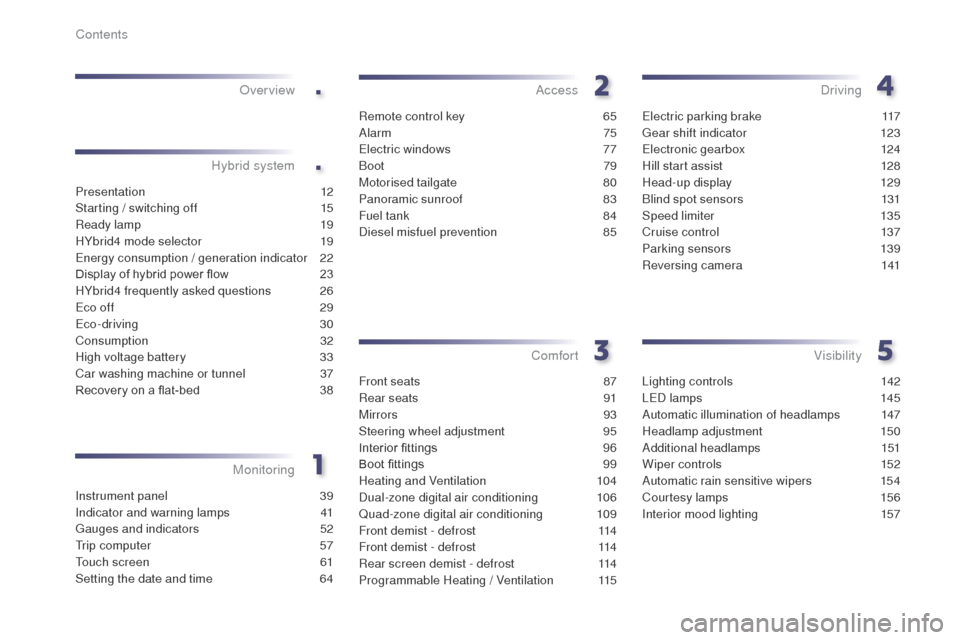
.
.
508RXH_en_Chap00a_sommaire_ed01-2014
Instrument panel 39
Indicator and warning lamps
4
1
ga
uges and indicators
5
2
tr
ip computer
5
7
to
uch screen
6
1
Setting the date and time
6
4
MonitoringOver view
Remote control key 6
5
Alarm
75
el
ectric windows
7
7
Boot
79
Motorised tailgate
8
0
Panoramic sunroof
8
3
Fuel tank
8
4
Diesel misfuel prevention
8
5
Access
Front seats 87
R ear seats
9
1
Mirrors
93
Steering wheel adjustment
9
5
Interior fittings
9
6
Boot fittings
9
9
Heating and Ventilation
1
04
Dual-zone digital air conditioning
1
06
Quad-zone digital air conditioning
1
09
Front demist - defrost
1
14
Front demist - defrost
1
14
Rear screen demist - defrost
1
14
Programmable Heating
/ Ventilation
1
15
Comfort
electric parking brake 1 17
ge
ar shift indicator
1
23
ele
ctronic gearbox
1
24
Hill start assist
1
28
Head-up display
1
29
Blind spot sensors
1
31
Speed limiter
1
35
Cruise control
1
37
Parking sensors
1
39
Reversing camera
1
41
Driving
Lighting controls 142
L
eD l
amps
1
45
Automatic illumination of headlamps
1
47
Headlamp adjustment
1
50
Additional headlamps
1
51
Wiper controls
1
52
Automatic rain sensitive wipers
1
54
Courtesy lamps
1
56
Interior mood lighting
1
57
Visibility
Hybrid system
Presentation
12
Starting / switching off
1
5
Ready lamp
1
9
HYbrid4 mode selector
1
9
en
ergy consumption / generation indicator
2
2
Display of hybrid power flow
2
3
HYbrid4 frequently asked questions
2
6
ec
o off
2
9
ec
o-driving
30
Consumption
32
High voltage battery
3
3
Car washing machine or tunnel
3
7
Recovery on a flat-bed
3
8
Contents
Page 10 of 338
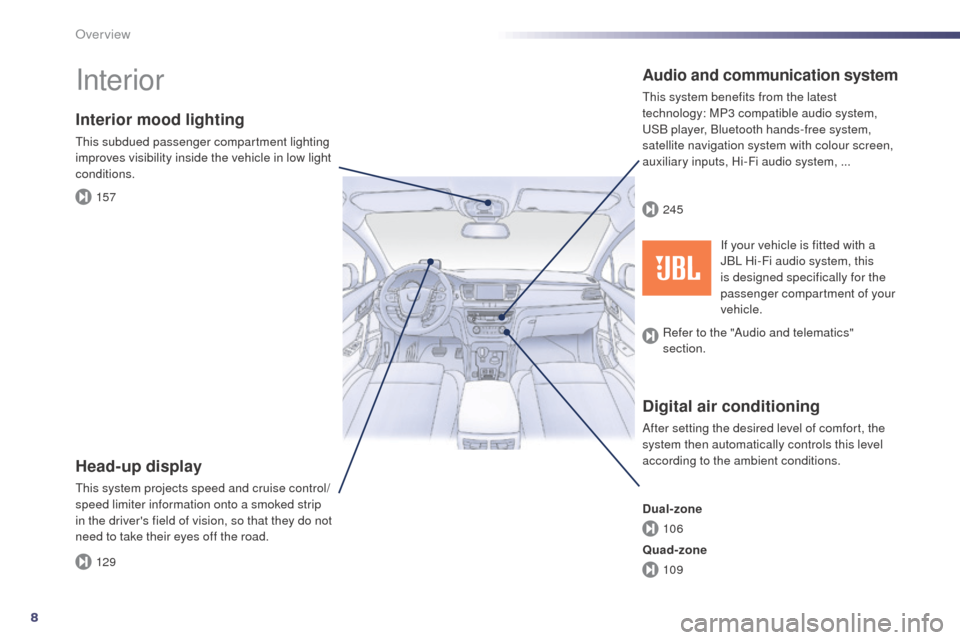
8
245
10 6
109
157
129
508RXH_en_Chap00b_vue-ensemble_ed01-2014
Interior
Interior mood lighting
this subdued passenger compartment lighting
improves visibility inside the vehicle in low light
conditions.
Head-up display
this system projects speed and cruise control/
speed limiter information onto a smoked strip
in the driver's field of vision, so that they do not
need to take their eyes off the road.
Digital air conditioning
After setting the desired level of comfort, the
system then automatically controls this level
according to the ambient conditions.
Audio and communication system
this system benefits from the latest
technology: MP3 compatible audio system,
uS
B player, Bluetooth hands-free system,
satellite navigation system with colour screen,
auxiliary inputs, Hi-Fi audio system, ...
Dual-zone
Quad-zone If your vehicle is fitted with a
JBL Hi-Fi audio system, this
is designed specifically for the
passenger compartment of your
vehicle.
Refer to the "Audio and telematics"
section.
Over view
Page 11 of 338
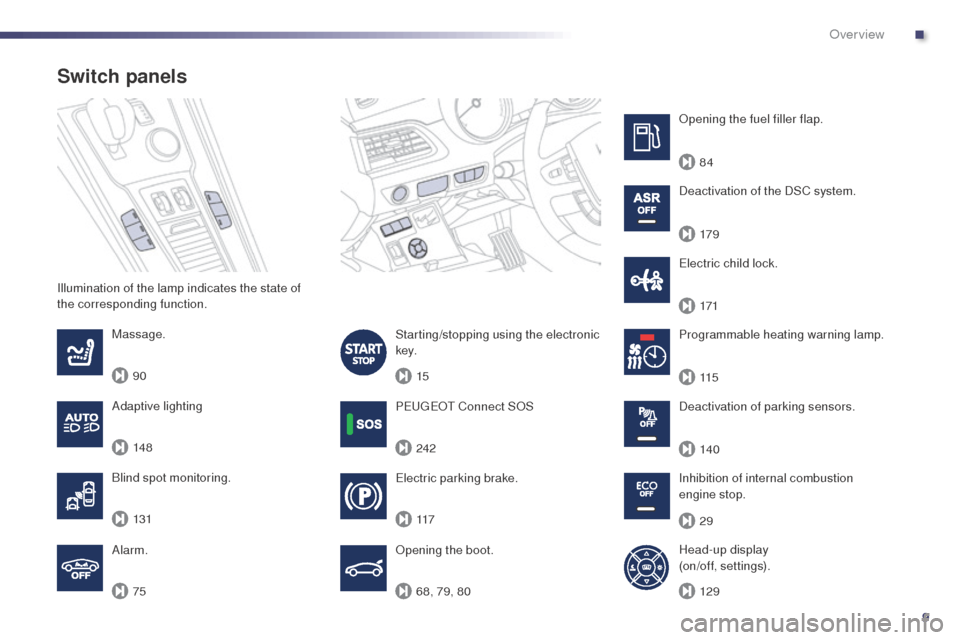
9
90
75 131 148117
68, 79, 80 242 15 171
115
140
29
129 179 84
508RXH_en_Chap00b_vue-ensemble_ed01-2014
Illumination of the lamp indicates the state of
the corresponding function.
Switch panels
electric parking brake.
Opening the boot.
Massage.
Alarm.
el
ectric child lock.
Programmable heating warning lamp.
Deactivation of parking sensors.
Inhibition of internal combustion
engine stop.
Head-up display
(on/off, settings).
Peuge
O
t
Connect SOS
Starting/stopping using the electronic
key.
Blind spot monitoring. Deactivation of the DSC system. Opening the fuel filler flap.
Adaptive lighting
.
Over view
Page 12 of 338
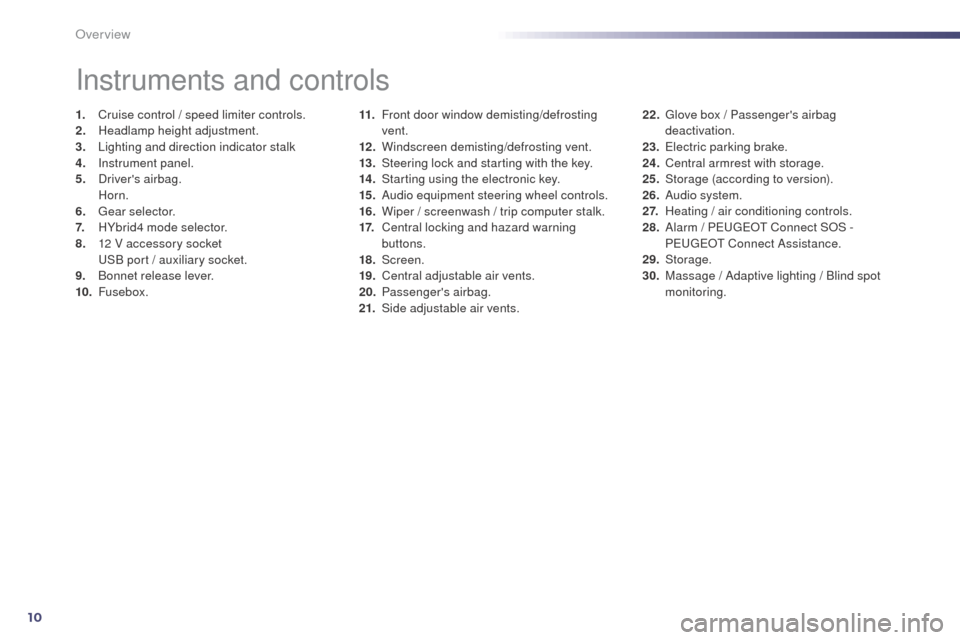
10
508RXH_en_Chap00b_vue-ensemble_ed01-2014
11. Front door window demisting/defrosting vent.
12 .
W
indscreen demisting/defrosting vent.
13.
S
teering lock and starting with the key.
14 .
S
tarting using the electronic key.
15.
A
udio equipment steering wheel controls.
16.
W
iper / screenwash / trip computer stalk.
17.
C
entral locking and hazard warning
buttons.
18.
Screen.
19.
C
entral adjustable air vents.
20.
P
assenger's airbag.
21.
S
ide adjustable air vents.
Instruments and controls
1. Cruise control / speed limiter controls.
2. H eadlamp height adjustment.
3.
L
ighting and direction indicator stalk
4.
I
nstrument panel.
5.
D
river's airbag.
Horn.
6.
g
ea
r selector.
7.
H
Ybrid4 mode selector.
8.
1
2 V accessory socket
u
S
B port / auxiliary socket.
9.
B
onnet release lever.
10.
Fusebox. 22.
gl ove box / Passenger's airbag
deactivation.
23.
e
l
ectric parking brake.
24.
C
entral armrest with storage.
25.
St
orage (according to version).
26.
A
udio system.
2 7.
H
eating / air conditioning controls.
28.
A
larm / Peuge
O
t Connect SOS -
Peuge
O
t Connect Assistance.
29.
Storage.
30.
M
assage / Adaptive lighting / Blind spot
monitoring.
Over view
Page 16 of 338
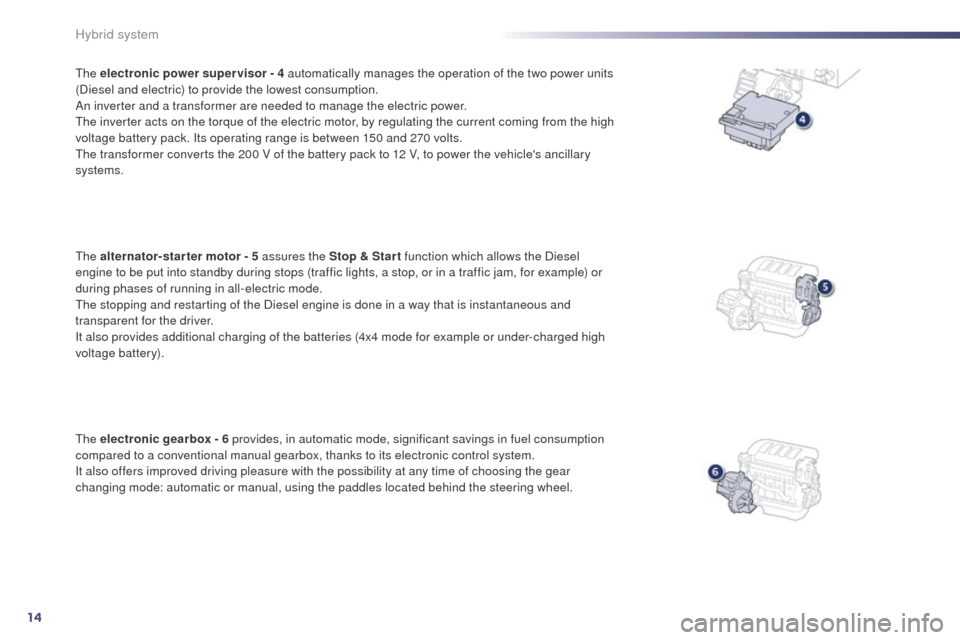
14
508RXH_en_Chap00c_systeme-hybride_ed01-2014
the electronic power super visor - 4 automatically manages the operation of the two power units
(Diesel and electric) to provide the lowest consumption.
An inverter and a transformer are needed to manage the electric power.
th
e inverter acts on the torque of the electric motor, by regulating the current coming from the high
voltage battery pack. Its operating range is between 150 and 270 volts.
th
e transformer converts the 200 V of the battery pack to 12 V, to power the vehicle's ancillary
systems.
th
e alternator-starter motor - 5 assures the Stop & Star t function which allows the Diesel
engine to be put into standby during stops (traffic lights, a stop, or in a traffic jam, for example) or
during phases of running in all-electric mode.
th
e stopping and restarting of the Diesel engine is done in a way that is instantaneous and
transparent for the driver.
It also provides additional charging of the batteries (4x4 mode for example or under-charged high
voltage battery).
th
e electronic gearbox - 6 provides, in automatic mode, significant savings in fuel consumption
compared to a conventional manual gearbox, thanks to its electronic control system.
It also offers improved driving pleasure with the possibility at any time of choosing the gear
changing mode: automatic or manual, using the paddles located behind the steering wheel.
Hybrid system
Page 29 of 338
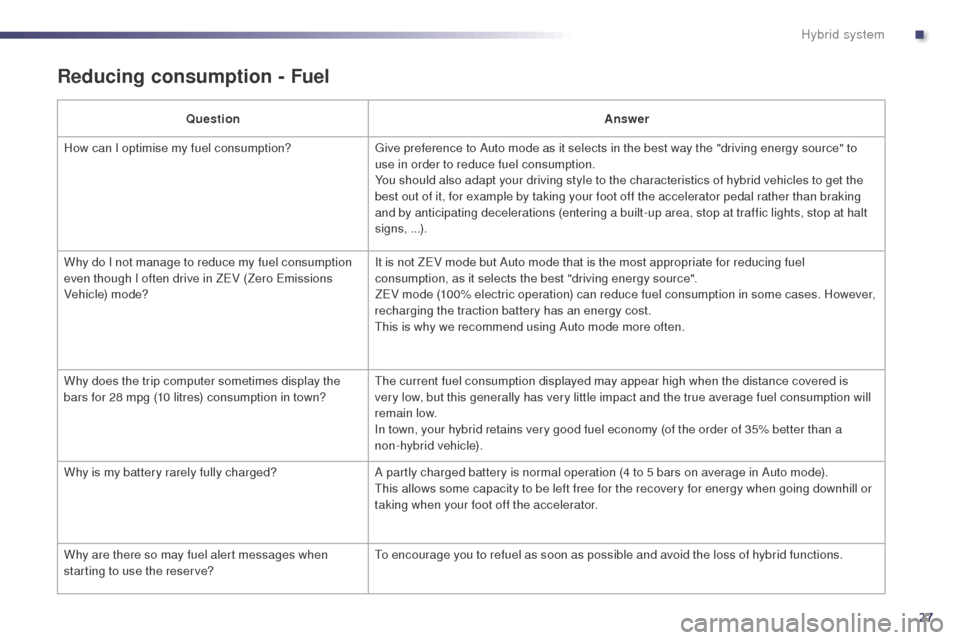
27
508RXH_en_Chap00c_systeme-hybride_ed01-2014
Reducing consumption - Fuel
QuestionAnswer
How can I optimise my fuel consumption?
gi
ve preference to Auto mode as it selects in the best way the "driving energy source" to
use in order to reduce fuel consumption.
You should also adapt your driving style to the characteristics of hybrid vehicles to get the
best out of it, for example by taking your foot off the accelerator pedal rather than braking
and by anticipating decelerations (entering a built-up area, stop at traffic lights, stop at halt
signs, ...).
Why do I not manage to reduce my fuel consumption
even though I often drive in Z
eV (
Zero e
m
issions
Vehicle) mode? It is not Z
eV m
ode but Auto mode that is the most appropriate for reducing fuel
consumption, as it selects the best "driving energy source".
Z
eV m
ode (100% electric operation) can reduce fuel consumption in some cases. However,
recharging the traction battery has an energy cost.
th
is is why we recommend using Auto mode more often.
Why does the trip computer sometimes display the
bars for 28 mpg (10 litres) consumption in town?
th
e current fuel consumption displayed may appear high when the distance covered is
very low, but this generally has very little impact and the true average fuel consumption will
remain low.
In town, your hybrid retains very good fuel economy (of the order of 35% better than a
non-hybrid vehicle).
Why is my battery rarely fully charged? A partly charged battery is normal operation (4 to 5 bars on average in Auto mode).
th
is allows some capacity to be left free for the recovery for energy when going downhill or
taking when your foot off the accelerator.
Why are there so may fuel alert messages when
starting to use the reserve?
to e
ncourage you to refuel as soon as possible and avoid the loss of hybrid functions.
.
Hybrid system
Page 32 of 338
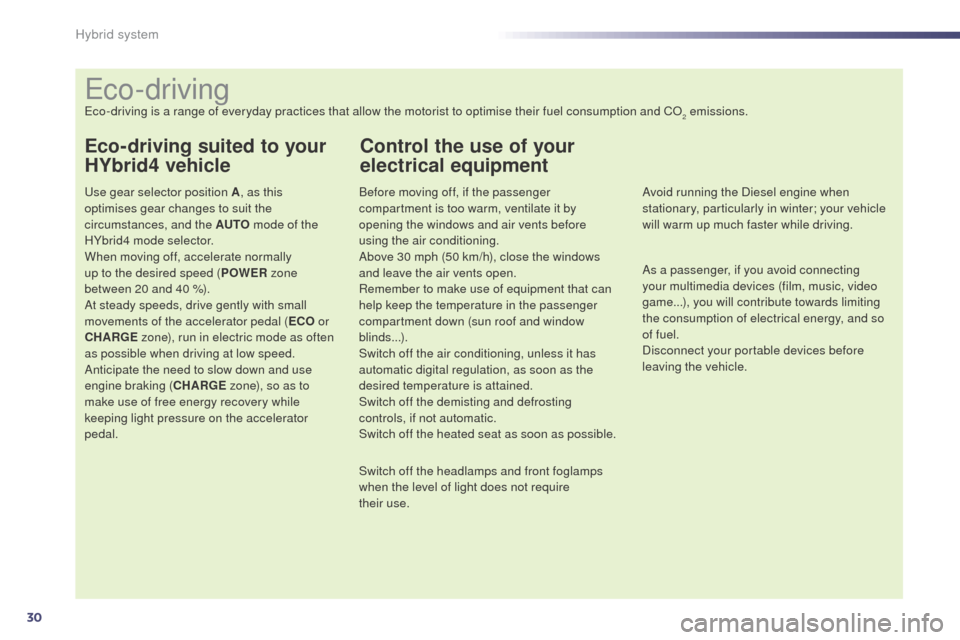
30
508RXH_en_Chap00c_systeme-hybride_ed01-2014
eco-driving
eco-driving is a range of everyday practices that allow the motorist to optimise their fuel consumption and CO2 emissions.
Eco-driving suited to your
HYbrid4 vehicle
use gear selector position A, as this
optimises gear changes to suit the
circumstances, and the AUTO mode of the
HYbrid4 mode selector.
When moving off, accelerate normally
up to the desired speed ( POWER zone
between 20 and 40 %).
At steady speeds, drive gently with small
movements of the accelerator pedal ( ECO or
CHARGE zone), run in electric mode as often
as possible when driving at low speed.
Anticipate the need to slow down and use
engine braking ( CHARGE zone), so as to
make use of free energy recovery while
keeping light pressure on the accelerator
pedal.
Control the use of your
electrical equipment
Before moving off, if the passenger
compartment is too warm, ventilate it by
opening the windows and air vents before
using the air conditioning.
Above 30 mph (50 km/h), close the windows
and leave the air vents open.
Remember to make use of equipment that can
help keep the temperature in the passenger
compartment down (sun roof and window
blinds...).
Switch off the air conditioning, unless it has
automatic digital regulation, as soon as the
desired temperature is attained.
Switch off the demisting and defrosting
controls, if not automatic.
Switch off the heated seat as soon as possible.
Switch off the headlamps and front foglamps
when the level of light does not require
their
use. Avoid running the Diesel engine when
stationary, particularly in winter; your vehicle
will warm up much faster while driving.
As a passenger, if you avoid connecting
your multimedia devices (film, music, video
game...), you will contribute towards limiting
the consumption of electrical energy, and so
of fuel.
Disconnect your portable devices before
leaving the vehicle.
Hybrid system
Page 41 of 338
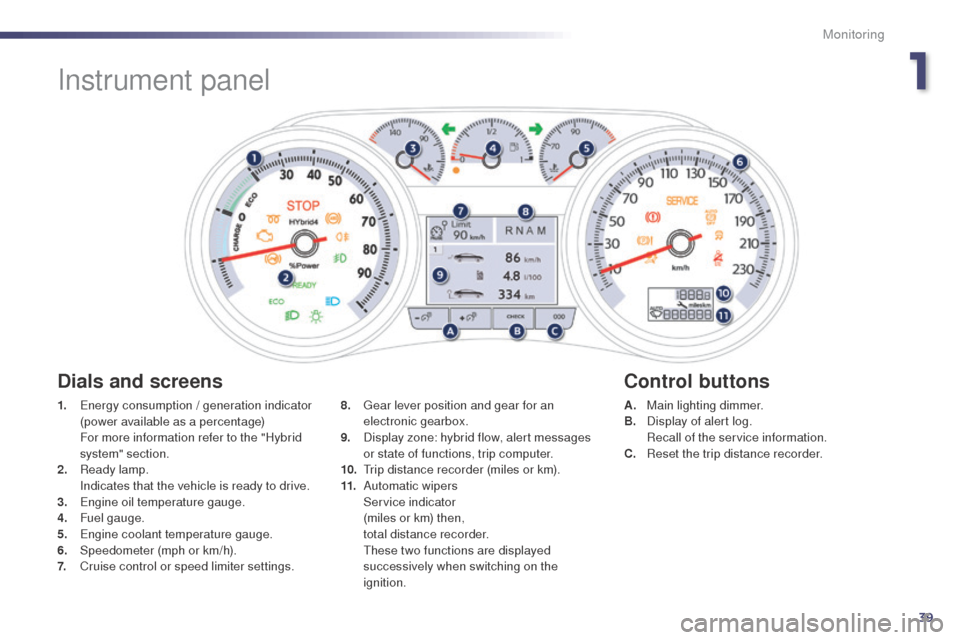
39
508RXH_en_Chap01_controle-de-marche_ed01-2014
Instrument panel
1. energy consumption / generation indicator (power available as a percentage)
F
or more information refer to the "Hybrid
system" section.
2.
R
eady lamp.
I
ndicates that the vehicle is ready to drive.
3.
e
n
gine oil temperature gauge.
4.
F
uel gauge.
5.
e
ng
ine coolant temperature gauge.
6.
Spe
edometer (mph or km/h).
7.
C
ruise control or speed limiter settings. A. M
ain lighting dimmer.
B. D isplay of alert log.
R
ecall of the service information.
C.
R
eset the trip distance recorder.
8.
ge ar lever position and gear for an
electronic gearbox.
9.
D
isplay zone: hybrid flow, alert messages
or state of functions, trip computer.
10.
t
r
ip distance recorder (miles or km).
11.
Aut
omatic wipers
S
ervice indicator
(
miles or km) then,
t
otal distance recorder.
t
h
ese two functions are displayed
successively when switching on the
ignition.
Dials and screens Control buttons
1
Monitoring
Page 42 of 338
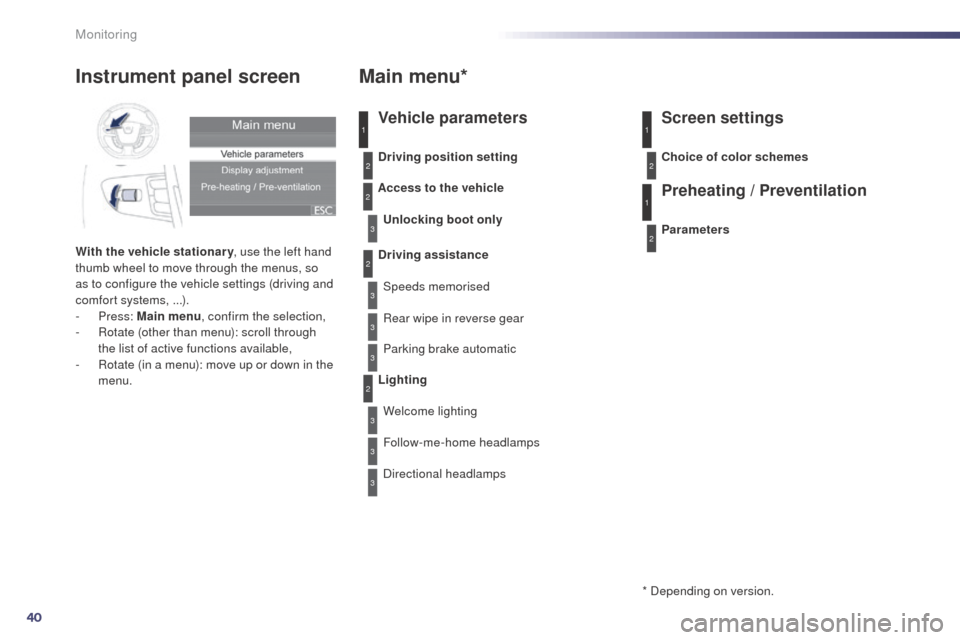
40
1
2
2
2
3
3
3
3
2
3
3
Instrument panel screen
With the vehicle stationary, use the left hand
thumb wheel to move through the menus, so
as to configure the vehicle settings (driving and
comfort systems, ...).
-
Press: Main menu , confirm the selection,
-
R
otate (other than menu): scroll through
the list of active functions available,
-
R
otate (in a menu): move up or down in the
menu.
Main menu*
Vehicle parameters Screen settings
Preheating / Preventilation
Driving position setting
Unlocking boot only
Driving assistance
Access to the vehicle
Speeds memorised
Rear wipe in reverse gear
Parking brake automatic
Lighting
Welcome lighting
Follow-me-home headlamps
Directional headlamps Parameters Choice of color schemes
3
1
2
1
2
* Depending on version.
Monitoring
Page 43 of 338
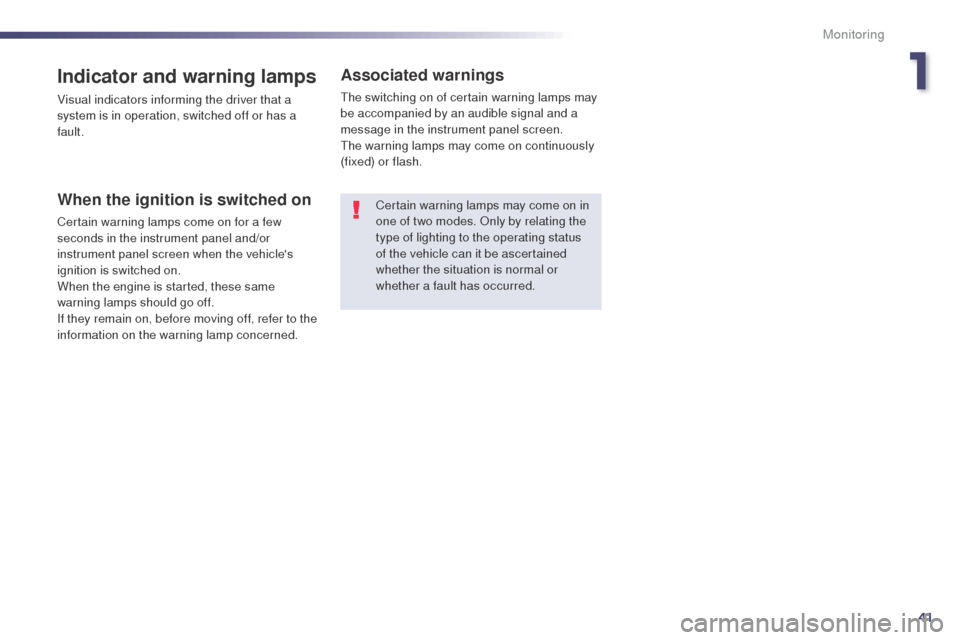
41
508RXH_en_Chap01_controle-de-marche_ed01-2014
Indicator and warning lamps
Visual indicators informing the driver that a
system is in operation, switched off or has a
fault.
When the ignition is switched on
Certain warning lamps come on for a few
seconds in the instrument panel and/or
instrument panel screen when the vehicle's
ignition is switched on.
When the engine is started, these same
warning lamps should go off.
If they remain on, before moving off, refer to the
information on the warning lamp concerned.
Associated warnings
the switching on of certain warning lamps may
be accompanied by an audible signal and a
message in the instrument panel screen.
th
e warning lamps may come on continuously
(fixed) or flash.
Certain warning lamps may come on in
one of two modes. Only by relating the
type of lighting to the operating status
of the vehicle can it be ascertained
whether the situation is normal or
whether a fault has occurred.
1
Monitoring